
Image Source: OTT
Is funding for transparency, participation, and accountability (TPA) decreasing? Who is funding TPA now? What specific issues and countries are they focusing on? I’ve been tracking analysis and speculation on these kinds of questions for years. I had a chance to really dig into the data earlier this year. Working together with a team from OTT Consulting, I undertook a landscape scan of funding to the field to inform the Hewlett Foundation’s TPA grantmaking strategy refresh process.
Some of the answers I found were unexpected or just not well-known. Funding in many TPA areas had increased from 2015 to 2019, contrary to what I had seen in some op-eds. Since other data wonks or TPA advocates might find this interesting, I’ve pulled together some charts that provide a sense of where funding is going or highlight less-well-known information. These charts should be viewed as complementing the work already done by the Organisation for Economic Co-operation and Development Donor Assistance Committee (OECD DAC) on bilateral donors.
A quick note on the data
These charts are all based on the data from OECD DAC. A variety of donors report data to the DAC, including bilateral donors, multilateral organizations, and multilateral development banks, as well as philanthropies and charities on their private development finance.
Most of these charts present data from 2019 (which was made available in 2021). Most data presented here is based on disbursements (rather than commitments) in million United States (US) dollars. Unless otherwise noted, aggregate figures of funding are for all funding reported, which includes multiple modalities (for example grants and loans). The OECD DAC Network on Governance recently published an accounting of trends in bilateral funding specifically.
The OECD DAC’s data is one of the most comprehensive and rigorous sources on international funding, but even then, the data may have errors due to incorrect reporting to sector codes or particular markers. Not all funders report to the OECD DAC either.
This data was originally analyzed for a landscape prepared by OTT Consulting for Hewlett Foundation. It accompanies a shorter brief tailored to funders.
1. Distribution of international funding to government and civil society across regions in 2019
Sub-Saharan Africa was the region that received the most international funding for government and civil society as reported to the OECD DAC, followed by South and Central Asia, Far East Asia, and South America. The majority of funding to sub-Saharan Africa and South and Central Asia was made through grants, while Far East Asia and South America received more funding through other types of official flows.
In terms of private development finance, about one-third was for activities that do not have a specified region, which includes the global level. When specified, the regions receiving the most private development finance was sub-Saharan Africa followed by the Caribbean and Central America, and then South America.
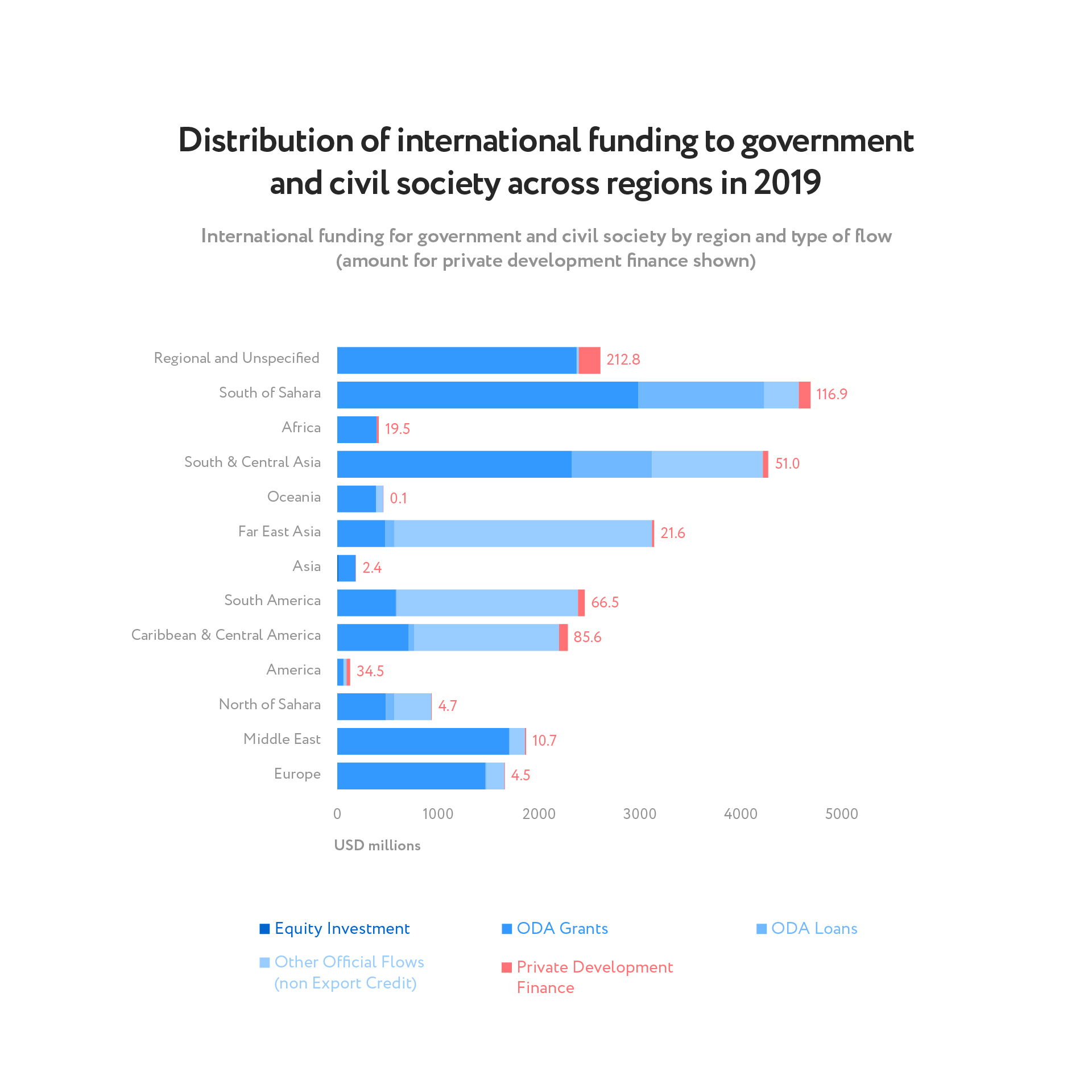
2. International funding to government and civil society in sub-Saharan Africa in 2019
There is a big disparity in funding to the government and civil society sector across sub-Saharan Africa. The reported levels of funding to some countries are significantly higher than others. The four countries with the highest level of reported funds to the government and civil society sector (over US $200 million each) were: Kenya, Nigeria, Ethiopia, and Niger. A further six countries received over US $150 million. The eight countries that received the least funding (less than US $5 million each) were: Equatorial Guinea, Mauritius, Botswana, São Tomé and Príncipe, Eritrea, Eswatini, and the Comoros.
Looking at the ratio of funding to population, however, the countries that received the most funding per person were those with lower populations, like Cabo Verde, Gabon, and Central African Republic. Nigeria was a top recipient by absolute funding but in the bottom ten by ratio of funding to population.

3. International funding to government and civil society in South America in 2019
The four countries with the highest level of reported funds to the government and civil society sector (over US $500 million each) were: Mexico, Ecuador, Colombia and Argentina. The four countries that received the least (less than US $10 million) were: Grenada, Belize, Suriname, and Guyana.
Looking at the ratio of population to funding, Costa Rica and El Salvador received the most on a per person basis and Venezuela and Brazil the least.
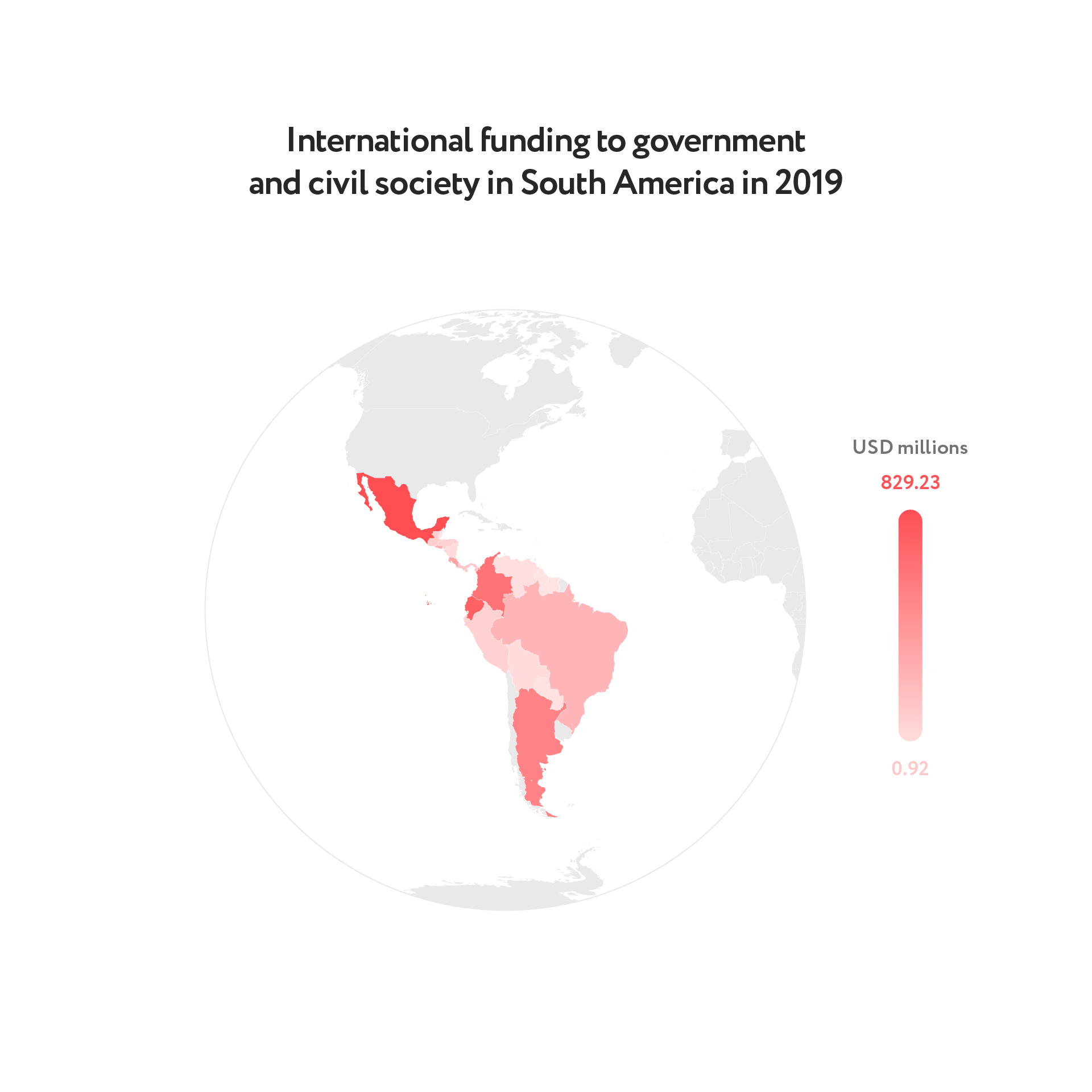
4. Funding to government and civil society sub-areas globally from 2015-2019
Most of the sub-areas under the government and civil society sector code received more funding globally in 2019 compared to 2015. Domestic resource mobilization and anti-corruption, in particular, saw greatly increased funding – with funding to anti-corruption organizations and institutions more or less doubling. Sub-areas that decreased include legislature and political parties; elections; and legal and judicial development.
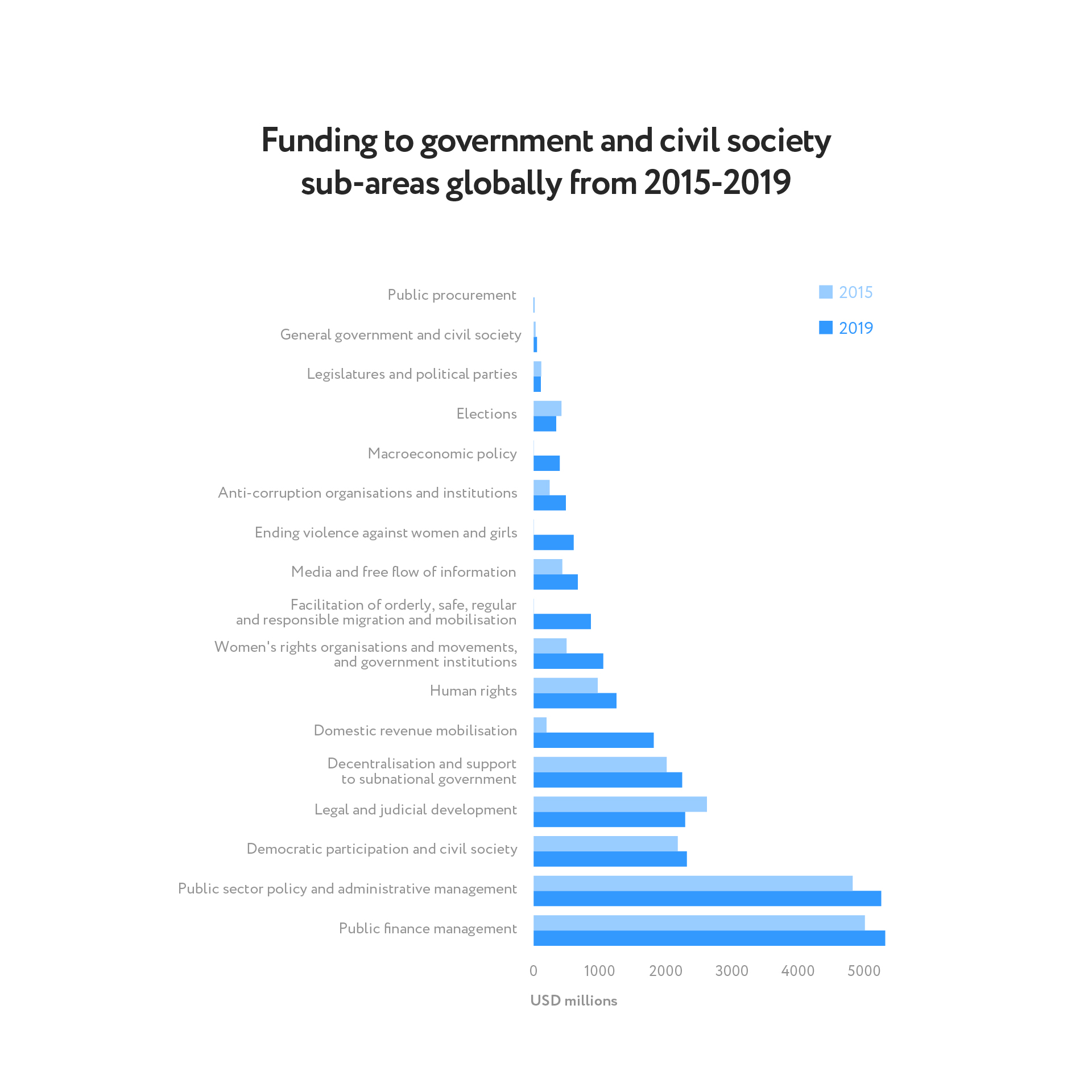
5. Gender equality marker changes over time
More disbursements were directed towards projects with gender equality as a significant objective in 2019 compared to 2015. However, disbursements to projects with gender equality as the principal objective has not changed much since 2015 (or even 2012).
As background, we wanted to get a sense of gender mainstreaming in the government and civil society sub-areas (meaning integration of gender into funding). The gender marker gives a rating as to whether a project includes gender equality as a principal (marked as 2), significant objective (marked as 1), or not targeted (marked as 0). We excluded two government and civil sector sub-areas (ending violence against women and women’s rights organizations) that provide for women-specific programming to ascertain the extent of gender mainstreaming in the other sub-areas. (Note that women’s rights organizations saw more funding in 2019 compared to 2015 globally and ending violence against women code began in 2015 for 2016 data).
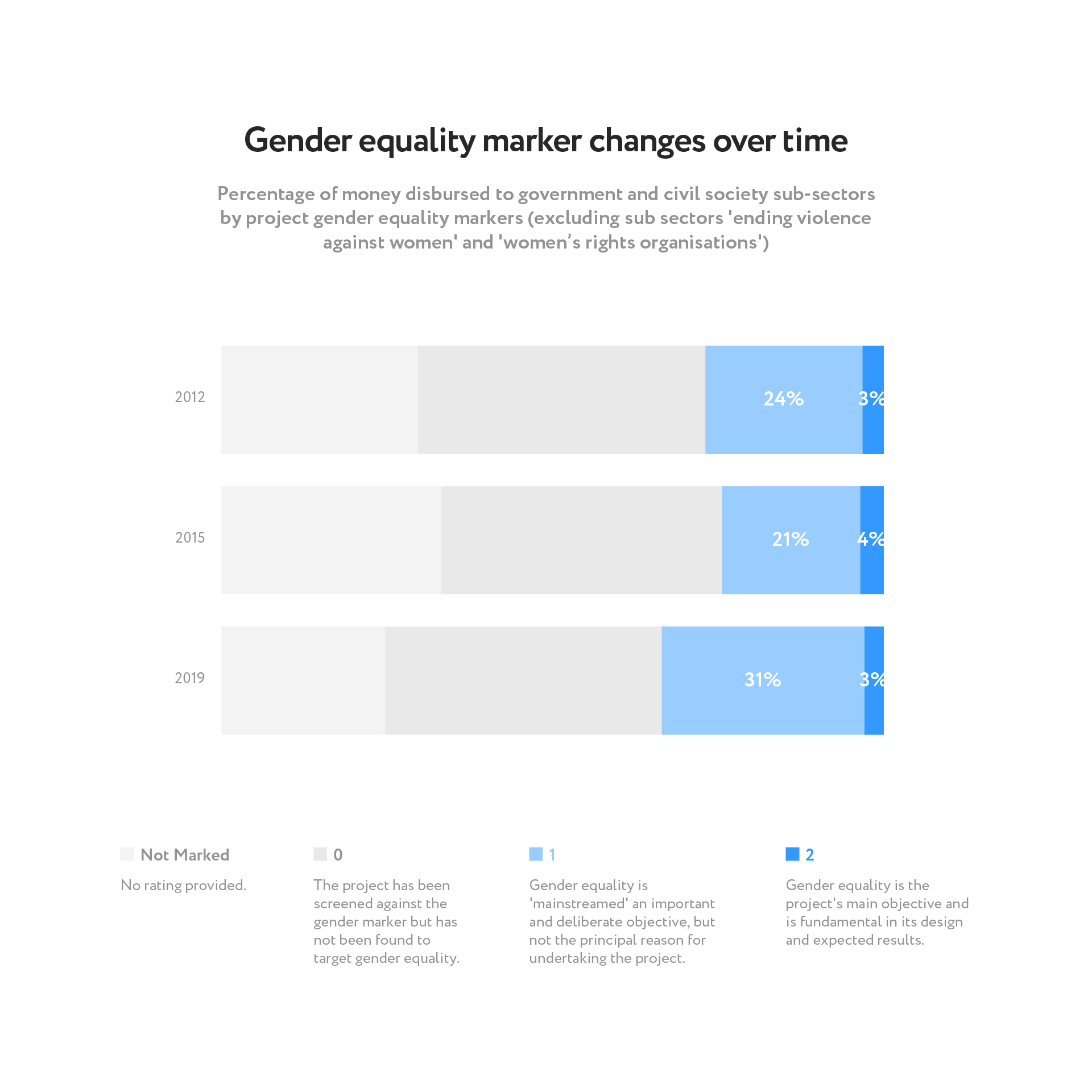
6. Public procurement funding in 2019
In 2019, only US $9.3 million in funding was reported to the Public Procurement code of the OECD DAC’s Creditor Reporting System. This figure seems too low. There are programmes that receive funding for public procurement not reported through this code, and other projects mentioning procurement were reported under different codes (like public financial management). Given the importance of procurement in COVID-19, hopefully, donors will look into their reporting to this code.
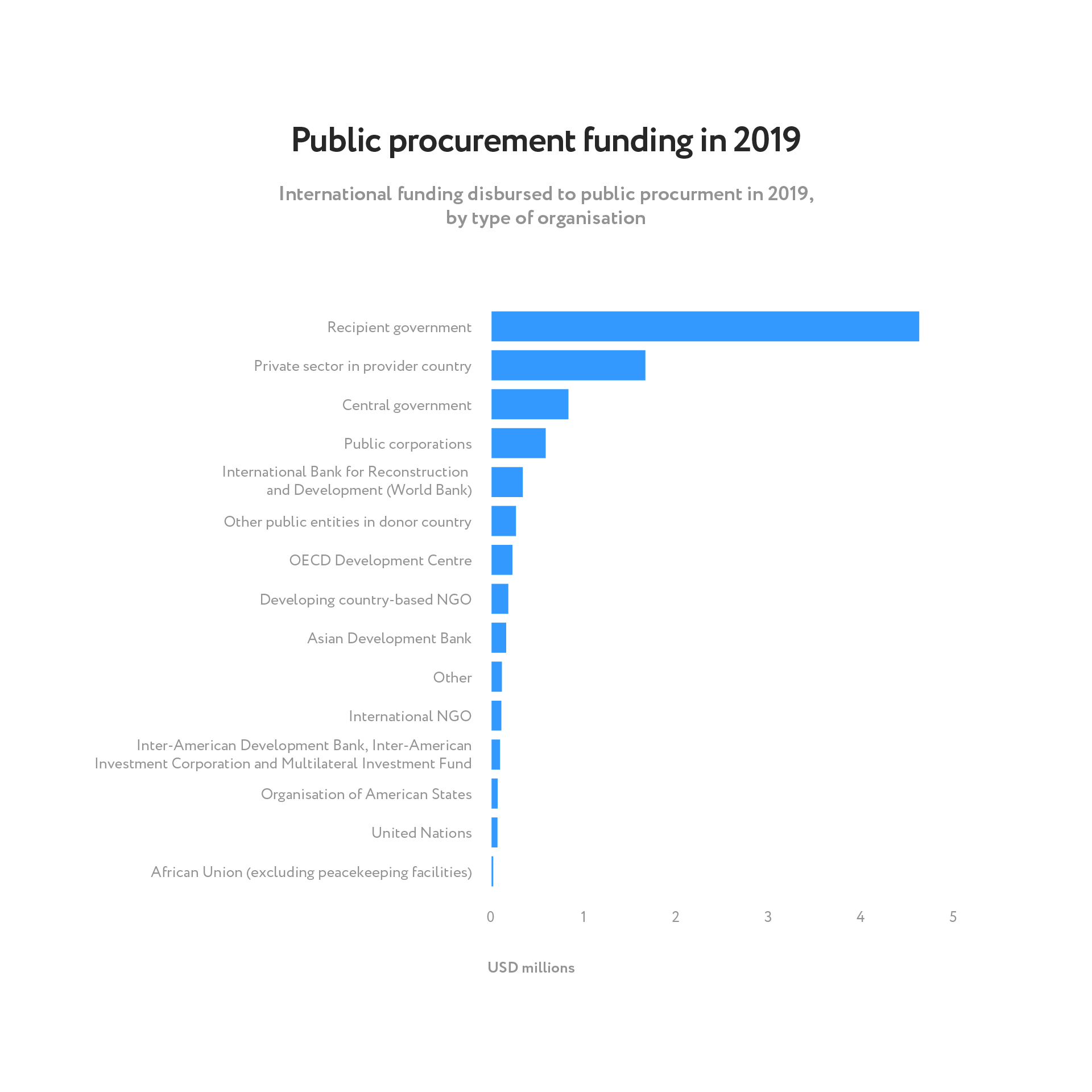
7. Funding to government and civil society through domestic, donor-country, and international NGOs from 2015-2019
In both 2015 and 2019, most of the funding to the government and civil society sector through NGOs was disbursed through donor-country NGOs. Funding through international NGOs (as a percentage of overall NGO funding) was up slightly in 2019 compared to 2015, and some of these international NGOs have headquarters in donor countries. (For the DAC, international NGOs have an international coordinating body facilitating the work of its members at the international level, or the NGO has an extensive network of country/regional offices in the field, or the NGO has internationally diversified sources of revenue.)
As a percentage of funding through NGOs, developing-country NGOs received 13% in 2015 and 15% in 2019. The trend is in a positive direction but seems minimal and is still at a low level. Thus far, therefore, rhetoric about ‘localizing’ and ‘decolonizing’ aid had not translated to disbursements.
The absolute numbers on funding provide an additional insight: funding through developing-country NGOs increased from 2015 to 2019 by over US$200 million, but funding through donor-country NGOs and international NGOs had increased even more.

8. Top countries receiving funding for public finance management (PFM), domestic resource mobilization (DRM), monetary institutions, and macroeconomic policy in 2019
COVID-19 has shown the importance of fiscal and monetary policies. While 2020 data is not yet available, in 2019, Indonesia stood out as the country marked as benefitting from the most funding in four related sub-areas: PFM, DRM, monetary institutions, and macroeconomic policy (as reported to the OECD DAC by all funders).
In 2019, PFM funding was over US $200 million in Ecuador, Pakistan, the Philippines, Uzbekistan, Costa Rica, and El Salvador. DRM disbursements were over US $100 million in Indonesia, the Philippines, Colombia, and Egypt. Overall, far less funding was disbursed to support monetary institutions and macroeconomic policy than PFM and DRM.
Looking specifically at private development funders, the top-named country recipients of this kind of funding were Nigeria (US $3.2 million), India (US $2.5 million), and Mexico (US $1.8 million) (not shown in this chart).

9. The 10 biggest funders of government and civil society in South America in 2019
In 2019, the Inter-American Development Bank (IDB) was the top funder (by disbursements) to government and civil society sub-sectors in South America (of those reporting to the OECD DAC). The government and civil society sub-sectors most funded by IDB were: PFM; public sector policy and administrative management; and anti-corruption work.
In addition, the World Bank, the US and Germany also disbursed more than US $100 million in the region. The sub-sectors most funded by the World Bank were PFM and DRM. The sub-sector most supported by the US was legal and judicial development. The sub-sectors with the most disbursements by all funders in South America were: PFM; public sector policy; DRM; anti-corruption work; and legal and judicial development.
The top philanthropic funder to this sector and region in 2019 was BBVA Microfinance Foundation at US $41 million, followed by the Ford Foundation at over US $14 million.
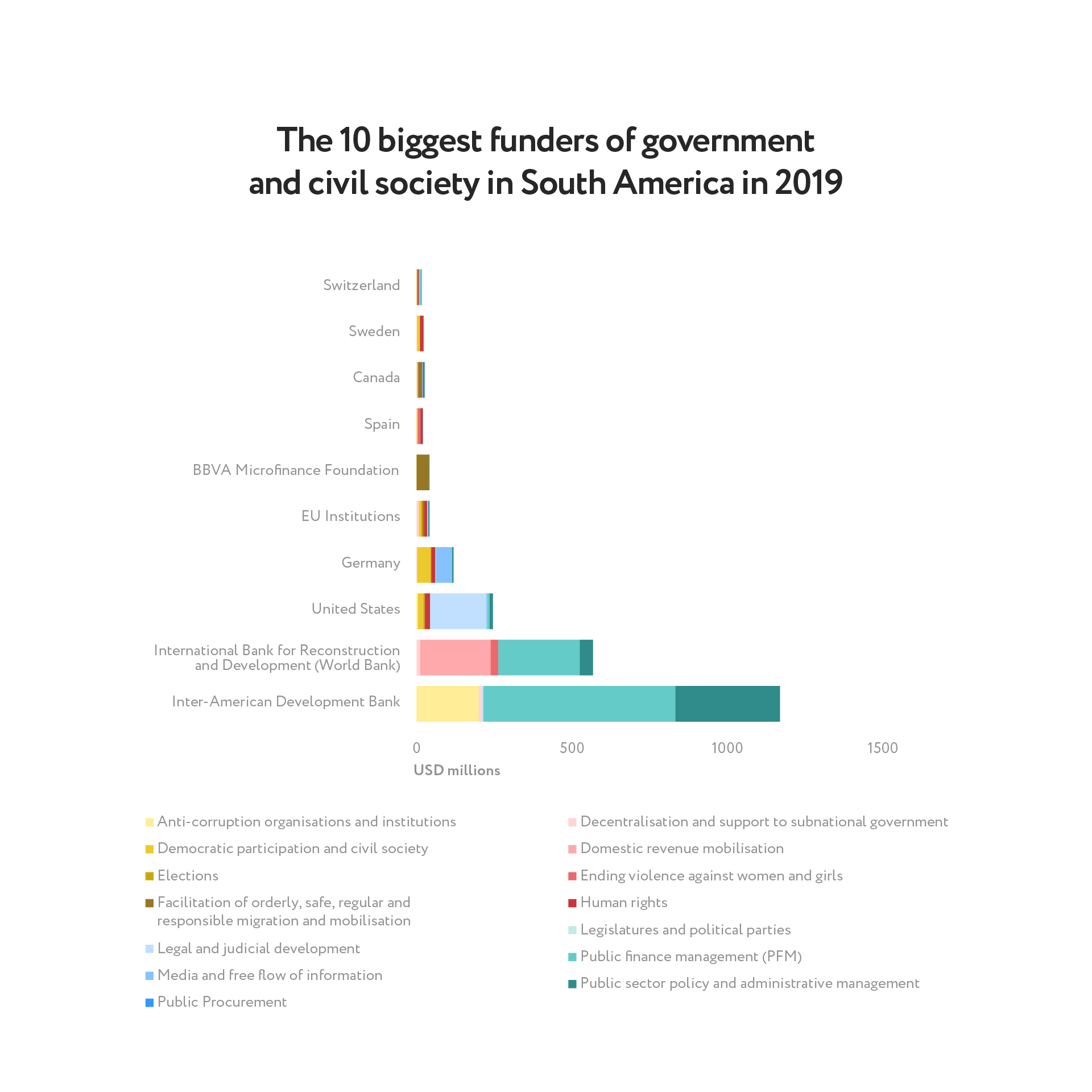
10. Top 10 funders to government and civil society in sub-Saharan Africa in 2019
In 2019, the funder with the most disbursements to the government and civil society sector in sub-Saharan Africa was the International Development Association of the World Bank at over US $1.4 billion. European Union institutions disbursed over US $400 million to the sector, while the US, Germany and the UK all disbursed over US $300 million.
The top philanthropic funder (that reports to the OECD DAC) to this region and sector was the Ford Foundation at over US $28 million.
The top five government and civil society sub-sectors by disbursements were: public sector policy and administrative management; public finance management; democratic participation and civil society; decentralization and support to subnational government; and domestic revenue mobilization.
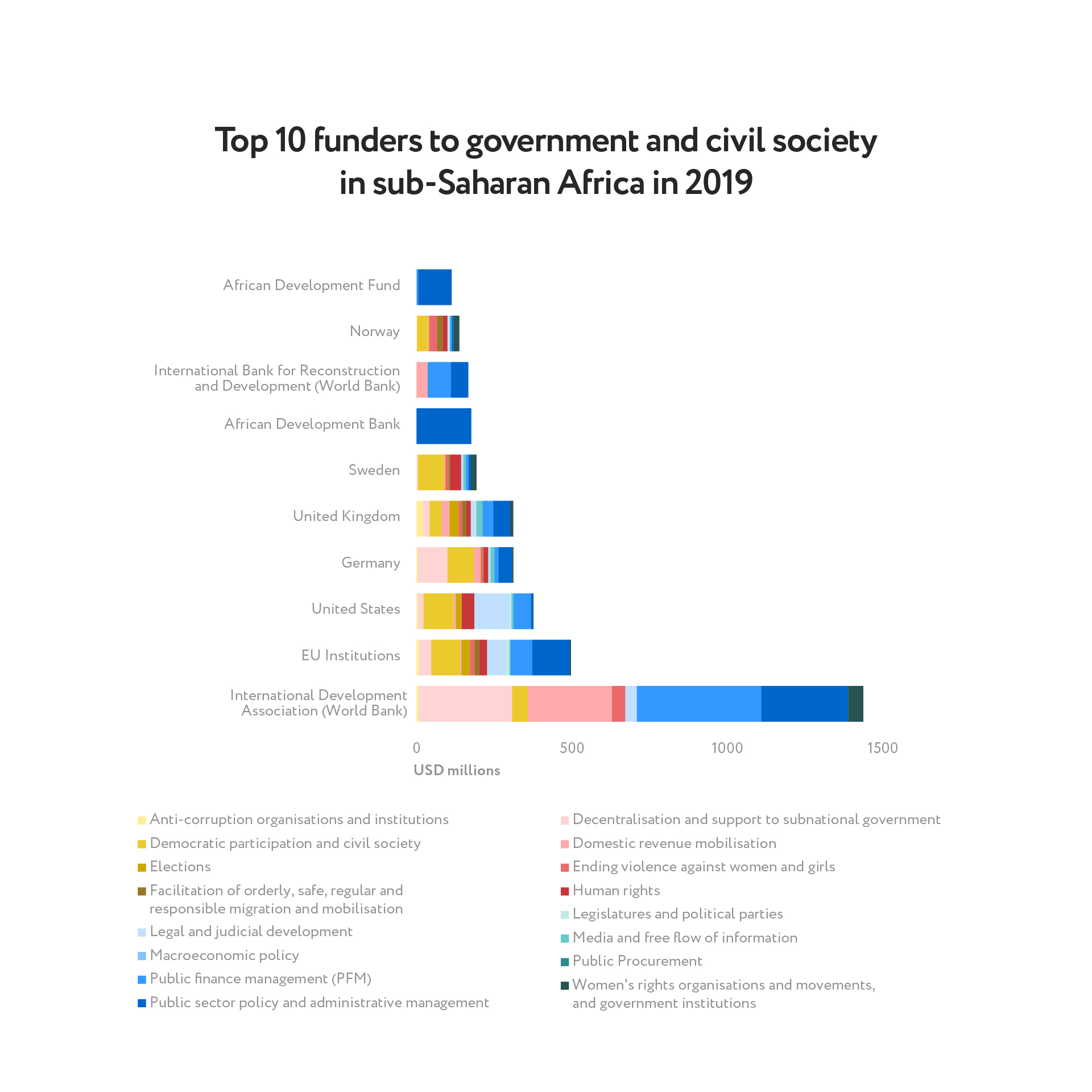
Read the accompanying brief: International funding for transparency, participation and accountability and COVID-19: trends and implications for funders.